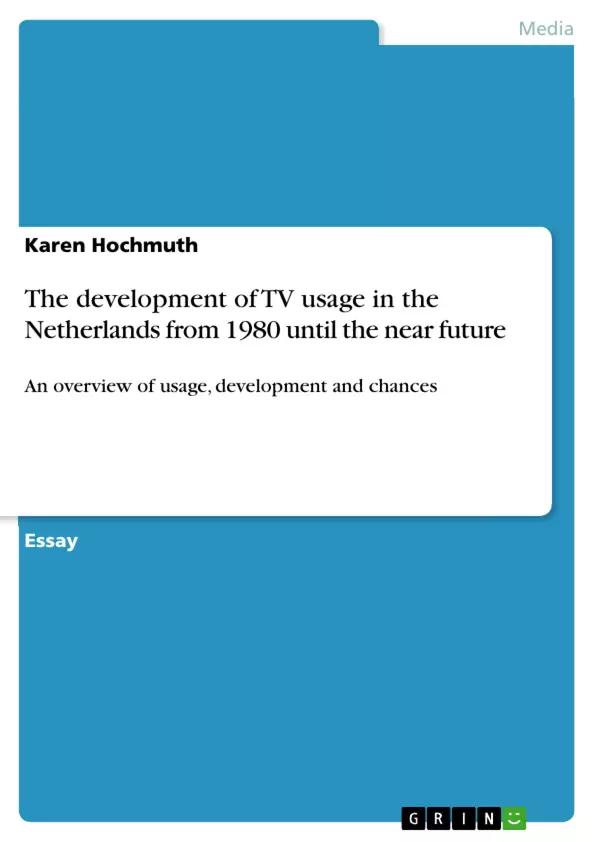In the Netherlands, fourteen million people out of a population of sixteen million have access to a television. In 2017, the number of people who made use of this medium sank about 3% in comparison to 2016. This means, that last year the Dutch watched TV around 178 minutes per day. Television has been, and still is an important medium for advertising, information and entertainment. But what is its role now, what was it 30 years ago, and what will the future hold?
The attention lays on how the consumption of TV shows and channels in the Netherlands is developing and what the current key points within this medium are. What are the risks, chances and opportunities, and what are the alternatives that the television as a medium is facing? Thus, the past, present and future of TV usage will be the guideline of this paper
Inhaltsverzeichnis (Table of Contents)
- The development of TV usage in the Netherlands from 1980 until the near future
- An overview of usage, development and chances
- Past
- Present
- Future
Zielsetzung und Themenschwerpunkte (Objectives and Key Themes)
This paper analyzes the evolution of television usage in the Netherlands from 1980 until the near future. It explores how TV consumption has changed over time, focusing on key factors like audience demographics, program preferences, and emerging technologies like streaming services and virtual reality.
- The changing role of television as a medium for information, advertising, and entertainment
- The impact of evolving technology on TV consumption habits
- The rise of streaming services and their influence on traditional broadcasters
- The potential of virtual reality and interactive media in the future of television
- The importance of targeted strategies for reaching diverse audiences
Zusammenfassung der Kapitel (Chapter Summaries)
- The paper begins by outlining the historical context of television usage in the Netherlands, citing research from 1987 that highlights the key reasons for watching TV at that time, such as loneliness, leisure, and specific program preferences. The influence of factors like education, social class, age, and free time on TV consumption is also discussed.
- Moving to the present, the paper examines current trends in television usage, focusing on the decreasing number of TV sets per household and the changing demographics of viewers. The paper discusses how younger generations are increasingly turning to online platforms for information and entertainment, leading to a shift in the audience for traditional television channels.
- Looking ahead, the paper explores the future of television consumption, emphasizing the growing popularity of streaming services like Netflix and the potential impact of virtual reality and interactive media. The paper discusses how traditional broadcasters are adapting to these changing trends, with a focus on developing niche content and incorporating new technologies.
Schlüsselwörter (Keywords)
This paper focuses on the development of TV usage in the Netherlands, analyzing key aspects like audience demographics, program preferences, the impact of streaming services, the future of television, and the need for targeted strategies for broadcasters in a rapidly evolving media landscape.
- Quote paper
- Karen Hochmuth (Author), 2018, The development of TV usage in the Netherlands from 1980 until the near future, Munich, GRIN Verlag, https://www.hausarbeiten.de/document/452234


